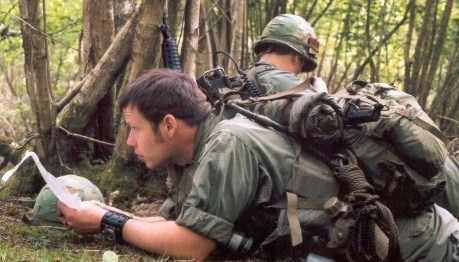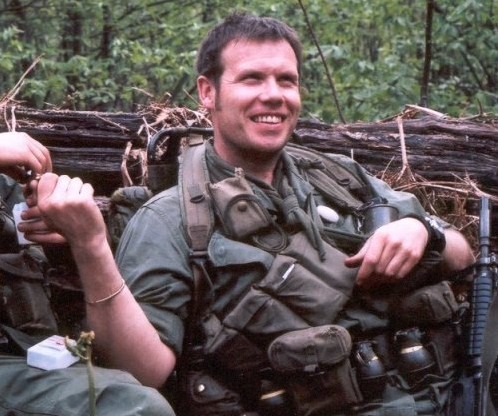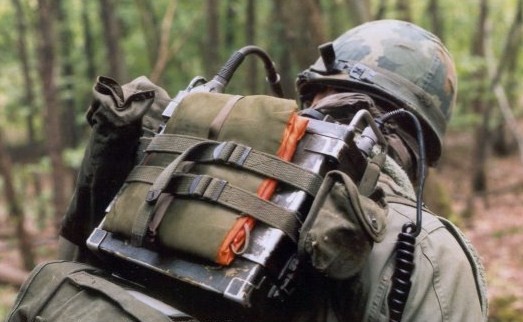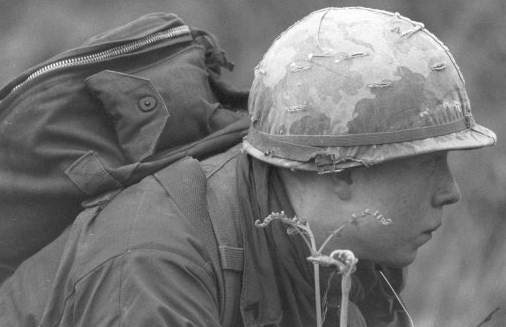
I can not stress enough how important it is to be true to your efforts to obtain "The Look". As a devotee to the the mission of portraying the Vietnam Soldier you are representing history. By taking part in re-enactment you are committing to the task of creating living history. The soldiers you will be portraying deserve to have you get it right. Your efforts should not be cheapened by half measures. Now this sounds serious, maybe stern......and it is. If you are looking to just play soldier, then stop reading the page now. Go play airsoft games with your buddies, this page is not for you.
If you are a member of a living history group, then read on! Are you looking for information to start a group and you want to get it right? Then keep reading! It is my goal to provide a tool that will help you to reach your goals. If you find reason to disagree with something I have placed in these pages, by all means contact me. m151dave@gmail.com Tell me what you have found to be wrong or in need of improvement.. State your sources, provide photographic proof if you can. Please don't waste time with "My buddy says...." or "I saw it in a movie...." or something like that. Facts and data, not stories and hearsay. I am striving for absolute fact, for the purpose of creating accurate information for those who have chosen to commit to the task of creating living history for the Vietnam era. Now, enough preaching, let's get down to business!!
Platoon Leader
The Platoon Leader is the most senior leader in the platoon. He is the person everyone else looks to for orders and sets the uniform standards. This makes him a target, so he should appear very much like a rifleman. The differences are very subtle, and the only way you should be able to identify him is by the RTO's surrounding him.

This platoon leader is studying his map co-ordinates, his watch strapped to his wrist and he has his RTO nearby. He is wearing poplin jungle fatigues with the shoulder sleeves rolled up. On his back is a lightweight rucksack and frame, the rucksack is hung in the lower position on the frame. Under the webbing straps is a poncho liner rolled in a poncho and tucked in underneath is a M1942 machete. On the frames side is a coil of rope, which partially obscures a M1956 canteen with cover. Around his waist and across his shoulder is a 7 pocket M16 bandoleer loaded with magazines. Off the webbing you can glimpse some M18 smoke grenades.

In this picture the same Platoon leader is seen, this time from the front. His webbing is not visible. The ammunition pouches are the smaller later variety better designed for the 20 round M16 magazines and hanging off each side of the amo pouch are M26 grenades. He has positioned his compass pouch lower on his suspenders and it rests on the right of his chest. Hung from his left shoulder and under his right arm is the 7 pocket cotton bandoleer. The straps you see that look like part of his webbing are in fact the rucksack shoulder straps. Note that the weapon resting next to him is a CAR-15, which is characteristic of a Platoon Leaders chosen weapon. Official designation for this weapon was XM177, the Air Force called them GAU-5's. GAU stands for Ground Assault Unit.

This picture shows a Captain of an Air Cavarly Division, he is probably a Company Commander. He wears the standard poplin jungle jacket, M1 helmet with Mitchell pattern cover and green olive drab t-shirt. He sports standard M1956 webbing with horizontal weave pistol belt. On his webbing he has two compass pouches, one of which is upside down. Both sides of his ammo pouches are sporting grenades and to the front is a pistol ammuniton pouch, suggesting he carries an M1911A1 - standard issue for Officers. Unusually this Captain has a Pilots Survival knife taped upside down on his suspenders. This is a personal preference, no doubt the Captain is hoping to facilitate a quick draw from the sheath, in a downward stroke into on-guard position. He carries a standard M16. Note he is wearing a army issue watch. Further note he has black on white name tapes, suggesting he has been in Vietnam in the early years of the war.

The final picture is of another Captain wearing an M1 helmet an unbadged jungle jacket, and trousers that are blossomed to his boots. Over his fatigues he wears an M1969 Fragmentation Jacket with 3/4 collar. He has standard M1956 webbing consisting of suspenders, pistol belt, 2 ammo pouches, compass pouch, M7 bayonet in M8A1 bayonet, and probably buttpack and 2 canteens (Although not visible here). Strapped to his left leg is a M18 Gasmask and Carrier, which slightly blocks the bayonet. On his left side is a M1916 holster containing a M1911A1 pistol. Take note that he wears a watch also, it is not threaded through a button hole on his shirt pocket as some troopers chose to do.
Here I have listed what I think you should have in your collection to display a typical platoon leader, above and beyound the basic combat equipment issue all the troopers would have in the US Army in Vietnam. Don't forget, even the LT has personal preferences for what he carries, just like any other troop, but he is expected to lead by example, so.....no Love Beads, Peace symbols, Hippie crap.
Uniform - Jungle jacket, trousers, M1 helmet with cover, T-shirt, socks, boxer shorts, combat boots.
Web Gear - standard system M1956 or M1967 webbing: This is belt, suspenders, two ammo pouches, two canteens with covers, buttpack (Optional), compass pouch, E-tool and cover.
Optional additional system equipment - 5 QT canteen, bayonet, machete
Existence Equipment - poncho and/or pup tent, poncho liner, mess tin and C-rations
Firearms & Accessories - Colt M16, M16A1 or XM-177 and at least three loaded cotton bandoliers, M1911A1 pistol, .45 magazine case with two magazines, M1910 holster or shoulder holster, fragmentation grenades, smoke grenade
Additional equipment - 1 claymore mine bag (to carryyour extra goodies), map case, Army issue compass, Army issue binoculars and case, Army issue wrist watch, lightweight rucksack w/frame, 550 parachute cord, M1952 or M1969 flak jacket.


Here is the "Look" for what a typical Squad Leader would look like and what he might be wearing. As the Squad Leader your general appearance is of a rifleman and the differences are very slight. If you were the enemy spying on a squad, the leader would be the person directing other soldiers, perhaps with arm signals or verbal communication, he might be using a RTO's radio or reading maps. But otherwise he would be no different. Most Squad Leaders prefer to carry the small CAR-15 which is easier to carry when doing other things like talking on the radio, but remember they were not always available to all those who wanted them. The Squad Leader below is talking on the squad's PRC. Squad Leaders, being NCO's, were entitled to carry an M1911A1 automatic pistol.

A squad leader and his RTO. Notice the radio is a PRC-10 and the RTO is carrying a fanny pack (seems to be empty) attached to the bottom of the radio carrier. He has some bug juice in his helmet band. Squad leader is wearing a lightweight tropical rucksack and frame with a machete attached. The antenna on the PRC is pulled forward and probably tucked into the loop on the front of the pack straps.

Lets examine this last photo for Squad Leaders. RTO is a PFC carrying an XM177 carbine. He has the green bug juice bottle in his helmet band. The antenna on the PRC is tucked in between his back and the radio carrier frame which would shorten the range of the unit considerably. The Squad Leader has a pack of smokes stuck in his helmet band. He is carrying some coiled rope and you can just see the edge of the pack frame on his lightweight tropical ruck. Notice the radio handset is enclosed in a plastic bag. Condoms were sometimes used, but this particular picture looks to be a looser plastic bag of some sort.

This section gives you an idea of what a typical Rifleman would look like and what he might be wearing. The basic 'Look' of a Rifleman is what you should aim to achieve when you start collecting. The rifleman pictured below has a OD green t-shirt under his poplin jungle jacket which is loosely worn. His webbing consists of M1956 suspenders and a vertical weave Davis belt. M26 grenades hang either side of two M1956 ammo pouches and a M1956 canteen with cover sits on his hip. Secured next to his left ammo pouch is a compass pouch with first aid dressing. On the back of his suspenders he has a rolled up poncho, probably secured by paracord to the back pad. In addition to the ammo pouches, he carries two fully loaded seven pocket cotton M16 bandoleers with 20 round magazines inserted.

The next rifleman pictured below wears a 3rd pattern jungle jacket with sleeves rolled down and jungle trousers. You can just make out his M1956 suspenders, ammo pouch, and vertical weave pistol belt. His compass pouch is situated on his left shoulder on the upper web keeper of the padded part of the suspenders. He has slung a seven pocket M16 bandoleer over his right shoulder and it hangs diagonally around his body under his left arm. The strap on the same shoulder apears to be a claymore mine bag, probably carrying additional ammunition. Notice neither of these two troopers have flak vest on. Not everybody wore them!

This third rifleman (Below) wears poplin jungle trousers and jacket with his sleeves partly rolled up. He wears M1956 webbing consisting of suspenders, belt, ammo pouches and compass pouch. Notice the M1956 ammo pouches are the shorter version designed to make the withdraw of magazines easier. Under his suspenders he has a field towel used as padding for carrying heavy loads. On his left hip you can just make out a M8A1 bayonet scabbard and a pair of yellow roping gloves.

In the final picture there is a team of five grunts consisting of three riflemen, a grenadier and a M60 gunner. This picture demonstrates the general look of a rifleman. All their fatigues are muddy and wet. Their trousers (except for the troop on the far right) are tied down in bloused fashion and the pockets on their trousers are stuffed full and bellowed. Jungle jackets are worn loosly and sleeves are rolled down. The far right grunt has his rolled up, but appears to be wearing a sleeping shirt underneath. Some of the grunts are wearing neckerchiefs around their necks, others have the field towel to soak up sweat. All are wearing the basic M1956 webbing or some variation. The grunt first left, has aquired a USMC flak jacket. Notice also our far right trooper is carrying a shotgun and a revolver in a loose fitting shoulder holster. Nobody is packing ammo belts for the m-60!

The basic look of the typical Grendier and what he might be wearing. The basic 'Look' of a grenadier is exactly like a rifleman accept for a change in weapon and associated equipment for the weapon. This Air Cavalry grenadier below wears the 3rd pattern jungle jacket and trousers. He has been in the field for sometime since much of the color in his uniform has been bleached out by the sun. These jungle uniforms fade very quickly under any amount of sunlight and you get a whole range of shades of green. Which incidently, makes it easy for use collectors. Under his uniform he wears an olive drab t-shirt and neckerchief around his neck. He sports the standard issue M1 helmet with mitchell pattern helmet cover and elastic helmet band.
He wears the M1956 webbing system with suspenders, pistol belt and compass pouch, probably carrying a first aid dressing, and he hangs a flashlight off the left suspender. If you look carefully you will notice that it isn't Vietnam issue, it has the plastic guards on either side of the switch! He has two varieties of ammo pouches as the far right one is the earlier sort with metal front plate and grometed retention strap. There is no problem with mixing these pouches, troopers would scrounge up what they could, new or old styles, it did not matter as long as it did the job they needed. The second is the later variation without these two features. He carries his 40mm ammunition in 1 bandoleer and 3 universal ammo pouches, which means he is carrying only 15 rounds. Notice he has a quick access round in his helmet band.

This grenadier (below) wears the M1956 webbing with buttpack, canteen and universal ammo pouch just visible. Grenadier's are one of those roles that are permitted to carry a sidearm. This grenadier carries a Colt 1911 in pistol holster and his ammunition in the .45 case is just visible in front of the holster. Notice his bulging trouser leg pockets, he packs as much as he can carry.

Our last grenadier pictured below (kind of old for PFC, maybe he got busted back?) wears the standard M1956 webbing with buttpack, canteen and pouches. He has M26 grenades attached to the side. He carries his M79 ammunition in the grenade vest. He is also carrying weapons oil (see the dispenser spout on the bottle) on his helmet, held in place with the elastic band. I am not sure about the clear bottle, I always saw green bottles when I was in. Anybody have a comment on this?

The M60 Gunner was a crital member of the squad. He had the ability to lay down a large volume of fire. He usually has an Assistant Gunner somewhere very close by to help with the ammo and laying of the gun. The Assistant Gunners job also included protecting to some degree the Gunner who is, needless to say, attracting a great deal of attention when he opens fire. Many members of the squad would be humping ammo for "The Pig", so it is always good to have a few belts of ammo scattered amoung your men in the squad. Remember to carry the belts like bandoleers and the bullets point out away from your neck, not inwards so they can jab you. Given the weight of the M60 machine gun your gunners were often of larger build or muscular in nature. You did not see a lot of 100 pound troops humping the Pig!
The 60 Gunner was issued an M1911A1 pistol, so he would have the magazine pouch on his web gear along with the pistol holster (black not brown). He would be carrying at least two spare belts of ammo. These might be carried in the small canvas bandoleer pouches which had a carboard box inside containing 100 rounds of ammunition, or they might be removed from the pouch and clipped together into a loop and worn that way. The gunner would also have the larger sized bottle of LSA lubricant handy. The Assistant Gunner would also be carrying the spare barrel bag which contained one spare barrel, an asbestose mitt to handle it with and various cleaning rods and tools.



The basis of this section is to give you an idea of what an RTO looks like and what he might be wearing. 'The Look' is exactly like a rifleman accept you have this great big radio strapped to your back. So you want to be a RTO? Here we can discuss what you should have in your collection to display a basic RTO in the US Army in Vietnam. Mind you this is what I think, so you don't have to go along with it. At the end of the day its up to you what you carry and how much weight you assign yourself. Along with all of your basic Rifleman load, you will be packing a radio, this could be a PRC77 or PRC25 or PRC10, with either the radio carrier or packframe with shelf. RTO's were targets! They often tried to hide the radio a bit. You often see claymore mine bags tied to the radio, used to carry spare batteries, flares, etc.. A radio assecories bag would also be attached to the straps holding the radio in place, this would contain antenna components, maybe a spare handset. A buttpack is attached below it. This RTO keeps his radio well masked and in doing so keeps his profile down. Remember RTO's are easy target to VC with their antenna acting like a flag. Take out the radio and you take out a valuable platoon resource.

This RTO is carrying a flare, two smoke grenades, an areal ID panel, map, radio accessories bag, machete and a pink flashlight. The radio is a PRC-10. I am not sure what the pouch is on the right. I wonder about the stuff being stored under the hold down straps. If they are pulled out to use, the radio would be loose on the carrier.

The RTO in this picture has an ID panel under his straps and on the left side there is an M-16 cleaning pouch (I think) and on the right is a case for an long wire antenna reel.

You see a towl under the shoulder straps on his pack straps. Being a Rifleman also, he is carrying an ammunition bandoleer.

Combat load means you would be carrying all your usual rifleman's equipment plus a radio. This isn't too much of a problem, however, full load is another deal altogether. RTO's basically carried everything a rifleman would have plus a radio and its extra accessories for a 36-hour period. This means spare handsets, antennas, and as many batteries as you think you will need (Two spare batteries does the trick fine). In Vietnam, batteries were one of those things that came on every supply chopper, but in re-enactment you won't have this luxury. If you can find a Packboard, then use this to attach your radio and other equipment. The PRC-25 has its own dedicated harness that can allow a buttpack to be fitted to the bottom. You have seen pictures of RTO re-enactors use these with claymore mine bags attached and they seem to be able to carry everything they need. On the pistol belt of the RTO below he has three M1956 canteens and what looks like dearskin roping gloves.

It has been very difficult to get a good picture of a typical medic, however there are few pictures here of soldiers wearing various bits of medical gear. Mostly consisting of the M5 medical bag.

In the picture above, amongst the group of soldiers is a medic with his bag turned to us. He has the earlier waterproofed canvas M3 bag secured to the back of his lightweight rucksack frame. It rests on his sleeping gear of poncho liner rolled in a poncho. Note the machette sticking out the left hand side of the pack. Other than his M3 bag you would not know otherwise his role within the platoon.

This picture is of a medic in the rear echelons of the platoon. You can clearly see his distinctive M5 medical bag bulked out with medical supplies.

In this picture, the medic is attending a wounded soldier. Not visible in this picture, he has his M3 bag open. Besides the M5 bag on his back, he carries a M1911A1 pistol in leather holster, which the medical corpsman were allowed to wear. In fact they were given the choice of either a pistol or M16, most chose to carry the M16.

This picture shows the M5 bag from the back being worn with the M1956 buttpack. Notice it interferes slightly with the wearing of a buttpack.







Here is listed what you should have in your collection to display a typical Medical Corpsman or 'Medic' in the US Army in Vietnam.
Along with the basic rifleman's equipment load the medic would have the M3 or M5 field medical kit as well as an M1911A1 .45 automatic pistol or an M16
Additional equipment
M3 Aid bag
M5 Aid
bag
4 M1956 Canteens
List of Contents:
SURGICAL SHEET WITH THE MEDICAL CADUCEUS
JACKSON SIZE 3 TRACHEOTOMY
CANNULA
1 MINOR SURGERY FIELD INSTRUMENT
8 GAUZE PETROLATUM DRESSINGS
2
- 11 3/4 INCH SQUARE DYED FIRST AID FIELD DRESSINGS
1 FIELD EYE DRESSING
KIT
2 ARMY TOURNIQUETS
1 BOX OF COTTON SWABS ON A WOODEN STICK
1 TIN OF
REXALL SURGICAL POWDER
2 BOTTLES OF WATER PURIFICATION TABLETS
1 TIN OF
SUNBURN PREVENTITIVE CREAM
4 TONGUE DEPRESSORS
1- 4 INCH COTTON ELASTIC
BANDAGE
2- 3 INCH COTTON ELASTIC BANDAGES
1- 3 INCH X 10 YARDS CAMOUFLAGED
GAUZE BANDAGE
3 TRIANGULAR BANDAGES
4 ROUND CONTAINERS OF 1 INCH X 6 YARDS
GAUZE ROLLER
1- 24 X 72 INCH GAUZE COMPRESS
1 INDIVIDUAL FIRST AID FIELD
DRESSING
1- 3 INCH X 6 YARDS CAMOUFLAGED GAUZE BANDAGE
3 BOXES OF FIELD
BAND-AIDS
1 TIN OF REXALL QUIK-BANDS BAND-AIDS
2 BOXES OF 1 INCH X 6 YARDS
GAUZE
1 BOX OF 3 INCH X 10 YARDS GAUZE ROLLER PLAIN
1 BOX OF 10
MERTHIOLATE SWABS
1 BOX OF 10 AMMONIA INHALANTS
1 TUBE OF TANNIC ACID
JELLY BURN COMPOUND
1 FIELD DRESSING IN A BROWN WRAPPER
1 TUBE OF
PETROLINE BACITRACIN OINTMENT
1 TUBE OF OPTHALMIC OINTMENT FOR EYE
INFECTIONS
1 PACKAGE OF 4 - 2X2 CAMOUFLAGED COMPRESS AND BANDAGE